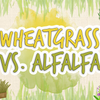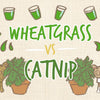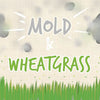Wheatgrass Vs Barley Grass: The Comparative Guide
Wheat and barley plants have been cultivated for over 6000 years and are still some of the most widely grown cereals in modern times. However, with the changing dietary needs, sprouted wheatgrass and barley grass are seeing increased attention. This guide will focus on wheatgrass vs barley grass, their health benefits, how to grow them, and how to consume them.
Not Much Time? Skip To What You'd Like To Learn...
-
What Is Wheatgrass?
-
What Is Barley Grass?
-
4 Differences Between Wheatgrass And Barley Grass
-
Which Is Healthier?
-
Wheatgrass, Barley Grass And Celiac Disease
-
Growing Differences
-
How To Consume
-
Where To Buy
-
History Of Barley Grass And Wheatgrass
-
Risks Associated With Consuming Barley Grass And Wheatgrass
-
Common Questions
What Is Wheatgrass?
Wheatgrass refers to freshly sprouted wheat shoots which are 6 to 10 days old. The sprouting process kicks off with a 12-hour prolonged activation soak followed by regular rinsing and draining every 8 to 12 hours. After the seeds are soaked for the first time, the germination process begins, which results in nutrient increase as the stored nutrients get broken down into simple molecules.
What Is Barley Grass?
Barley grass refers to 14-day old barley sprouts. To start off, mature, dry barley seeds need to be activated by soaking for at least 12 hours. This is followed by regular rinsing and draining for 12 to 14 days after which the fresh microgreens can be harvested. Barley grass sprouts are considered to be mature when they are about 8 inches long.
4 Differences Between Wheatgrass And Barley Grass

1. How Long to Grow
Wheatgrass takes less time to mature compared to barley grass, below is the full explanation:
Wheatgrass begins to sprout on the second day and ready to harvest by the sixth to the tenth day.
Barley grass, on the other hand, takes 12 to 14 days to reach maturity while the initial sprouting takes place in under a day.
2. Consumption Differences
Raw Wheatgrass can be consumed in the form of wheatgrass juice while barley grass juice is considered too bitter to drink directly so it will require additional fruit juice to tone down the taste notes.
Raw wheatgrass can be consumed in various ways ranging from fresh to frozen, wheatgrass juice, or blended and added to salads. Commercially grown wheatgrass is usually dried and processed into wheatgrass powder or capsule and tablet supplements.
Barley grass is best consumed in the form of barley grass juice and smoothies. This microgreen can be processed via dry freezing and grinding it into powder. Barley grass powder is often used to make barley grass powder balls that are healthy and tart. Commercially processed barley grass supplements can be bought in the form of tablets and capsules.
3. Where They Grow
Wheatgrass grows best indoors while barley grass is best grown outside in order to increase its chlorophyll content.
Wheatgrass can be grown either indoors or outdoors if the indoor temperature is kept within the optimal range of 60 to 75° F (15.5 – 24°C) and the sprouts are rinsed and drained regularly they can be grown anywhere in the world. Wheatgrass can also be grown outdoors in the temperate regions throughout the United States and Europe.
Barley grass grows best outdoors on well-drained soil with organic compost. However, barley grass can still be grown indoors by replicating the required conditions such as temperature and moisture content. You will need to use a bright light to increase chlorophyll content which increases nutrient content.
4. Taste
Barley grass has a milder taste compared to that of wheatgrass, below is the full explanation:
Wheatgrass has a bland taste with hints of mild tartness and slightly earthy flavor that's often associated with green tea. The taste will take some time to get used to but if you can't tolerate it just add an equal amount of freshly pressed apple juice.
Barley grass has a milder taste that's often categorized as bitter. Freshly cut barley grass has a pungent aroma which can be unpleasant to drink. Adding freshly squeezed apple or blueberry juice will tone down the bitter aftertaste in barley grass juice.
Which Is Healthier?
The only way to gauge these microgreens is by comparing the nutritional benefit of each and the amounts present in a single serving.
Barley grass is hands down more nutritious compared to wheatgrass thanks to the higher nutrient, vitamin and mineral content.
Wheatgrass, Barley Grass And Celiac Disease
Both wheat and barley grains contain gluten which is a group of proteins that give the dough its chewy texture and helps it rise by trapping carbon dioxide gas within as the dough rises.
[Disclaimer: Always check the labels on ACV and wheatgrass products to ensure that they do not contain any compounds that might trigger adverse reactions in your body.]
What Is Celiac Disease?
Celiac disease is classified as an autoimmune disease that's triggered by the consumption of gluten in genetically predisposed people. Once consumed, gluten will trigger the destruction of small intestine cells which cause irritation and other abdominal discomforts.
Can You Eat Wheatgrass Or Barley Grass When Suffering From Celiac Disease?
Yes, wheatgrass and barley grass are considered to be gluten-free as the germination process leads to the breakdown of gluten into simple amino acids which are easily absorbed in the digestive system. The young microgreens also do not produce gluten until they reach the flowering stage.
Growing Differences
Just like other microgreens, wheatgrass and barley sprouts can be grown either indoors or outdoors. The only differences in the growing process arise in the number of growing days and exposure to sunlight.
How to Grow Wheatgrass Indoors
Equipment Needed
-
A large glass bowl for soaking
-
10 x 10-inch sprouting tray- should be equipped with small-sized drainage holes
-
Plastic lid with holes
-
Sprouting jar fitted with a sprouting lid
Supplies Needed
-
1 cup wheat sprouting seeds
-
Compost enriched soil
-
Tap water
Instructions
1. Rinse the cup of sprout ready wheat seeds and remove any stones and debris that might be present
2. Place the wheat seeds in a large glass bowl, and half fill it with cold water
3. Set aside the bowl for at least 8 to 12 hours, alternatively, you can leave the seeds to soak and activate overnight
4. Rinse and drain the seeds before transferring them into a sprouting mason jar. The jar should be equipped with a sprouting mesh or lid which will hold back the seeds while allowing water to drain out and fresh air to get in
5. Place the sprouting jar inverted at an angle so that the water can drain out on its own. The sprouting jar should then be kept away from direct sunlight and within the optimal temperature range of 70° to 75° F (12° to 25°C)
6. Rinse and drain the sprouts at least twice per day for the next three days or until when the tails begin to show
7. Add half an inch-deep layer of compost-enriched soil to the sprouting tray
8. Gently water the soil to moisten it taking care not to form puddles
9. Lightly sprinkle the sprouted wheat seeds evenly across the tray taking care not to break the young shoots
10. Sprinkle loose soil over the seeds until a thin layer of the soil covers them
11. Place the tray within 60-80ºF and away from direct sunlight
12. Cover the project with a second tray or plastic lid with holes to create a greenhouse effect
13. Water the setup daily while avoiding overwatering. Take off the lid when the sprouts grow 1 to 2 inches tall
14. Harvest the microgreens before they develop a second blade as the nutritional content will be much lower
How To Grow Barley Grass Indoors
Equipment Needed
-
A large glass bowl for soaking
-
10 x 10-inch sprouting tray- should be equipped with small-sized drainage holes
-
Plastic lid with holes
-
Sprouting jar equipped with a sprouting lid
Supplies Needed
-
1 cup sprout-ready barley seeds
-
Compost enriched soil
-
Tap water
Instructions
1. Rinse the cup of sprout ready barley grains and remove any stones and debris that might be present
2. Place the wheat seeds in a large glass bowl, and half fill it with cold water
3. Set aside the bowl for at least 8 to 12 hours, alternatively, you can leave the seeds to soak and activate overnight
4. Rinse and drain the seeds before transferring them into a sprouting mason jar. The jar should be equipped with a sprouting mesh or lid which will hold back the seeds while allowing water to drain out and fresh air to get in
5. Place the sprouting jar inverted at an angle so that the water can drain out on its own. The sprouting jar should then be kept away from direct sunlight and within the optimal temperature range of 70° to 75° F (12° to 25°C)
6. Rinse and drain the sprouts at least twice per day for the next three days or until when the tails begin to show
7. Add half an inch-deep layer of compost-enriched soil to the sprouting tray
8. Gently water the soil to moisten it taking care not to form puddles
9. Gently sprinkle the sprouted wheat seeds evenly across the tray taking care not to break the young shoots
10. Sprinkle loose soil over the seeds until a thin layer of the soil covers them
11. Place the tray within 60-80ºF and away from direct sunlight
12. Cover the project with a second tray or plastic lid with holes to create a greenhouse effect
13. Water the setup daily while avoiding overwatering. Take off the lid when the sprouts grow 1 to 2 inches tall
14. To increase the chlorophyll content of the microgreens simply move them into a well-lit room or even outside under the direct sunlight. Ensure that the soil medium is kept moist due to the increased temperature. This can be done for 3 to 5 days.
Conclusion
Growing wheatgrass and barley grass require almost the same level of effort except for the final stage where barley grass does need extra light to increase its chlorophyll content.
How To Consume

Wheatgrass
Wheatgrass can be consumed raw or in its processed form.
Juice - Freshly harvested wheatgrass can be blended or processed using a juicer into fresh wheatgrass juice. Wheatgrass juice has a strong flavor which some might find hard to keep down, use crisp apple or fruit juice to tone it down.
Wheatgrass juice recipe: link
Smoothies - Fresh wheatgrass can be pureed into a nutrient-rich smoothie that can be further boosted with other raw fruits such as oranges to give it a zesty flavor.
Wheatgrass smoothie recipe: link
Shots - If you are hardcore enough to consume unflavored wheatgrass juice, then wheatgrass shots are your thing. Freshly juiced wheatgrass shots are best consumed on an empty stomach to increase nutrient absorption.
Wheatgrass shots recipe: link
Supplements - Commercially grown wheatgrass is often dried and processed into a powder which is often sold as a supplement in the form of tablets and dry wheatgrass powder. In its processed form, wheatgrass does retain most of its nutrients albeit not as healthy as freshly harvested wheatgrass.
Wheatgrass powder juice recipe: link
Barley Grass
Barley grass can be found either freshly harvested or in its powder form after processing.
Juice - Freshly pressed barley grass juice has a mildly bitter flavor which often requires other sweet ingredients to be added to tone down the flavor.
Barley grass juice recipe: link
Smoothie - Pureed fresh barley grass matches perfectly with frozen bananas and almonds to form this refreshing smoothie recipe: link
Powder - Barley grass powder has a longer shelf life compared to freshly harvested wheatgrass. Its applications are also not limited to just quick-fix barley grass powder juice; it can also be used to make barley grass powder balls.
Barley grass powder balls recipe: link
Where To Buy
Wheatgrass - Wheatgrass has a low shelf life which makes it harder for shops to stock up on these sprouts. Amazon prefers to stock up on frozen wheatgrass juice and dry wheatgrass powder. If you want freshly harvested wheatgrass, your best bet will be to try the nearest farmer's market and local vegan or health food store.
Our Recommended Wheatgrass Product
Brand: Wow Frozen Wheatgrass Juice
[Check The Latest Price Here]Barley Grass - Just like any other microgreen, barley grass has a limited shelf life which makes it almost impossible for stores to stock up on fresh barley grass. Instead what you will find on Amazon and other sellers is barley grass powder. Freshly harvested barley grass can be found in farmers markets and fresh produce stores.
[Check The Latest Price Here]
History Of Barley Grass And Wheatgrass
Wheatgrass - Wheatgrass was traditionally used by both Persian and Indian cultures in their festivals and rituals. The sprouts were introduced to the western world in the early 1930s by Charles Schnabel, who sold the first powdered grass to major drug stores throughout the United States.
Barley Grass - Humans have used barley grass for thousands of years with archeological evidence pointing to its first use by the Egyptians, Romans and Vikings. Columbus brought barley to the Americas in 1493 and ever since it's been considered as one of the most widely grown grains in North America.
Risks Associated With Consuming Barley Grass And Wheatgrass
Both barley grass and wheatgrass are considered to be high-risk foods due to the possibility of contamination during the sprouting process.
What is the risk of barley grass and wheatgrass?
The significant risk in consuming barley grass and wheatgrass is the possibility of getting a bacterial infection from opportunistic bacteria cultures which might contaminate the sprouts during the rising and draining processes.
Common Questions
Which Is Better Wheatgrass Or Barley Grass?
Barley grass has more nutritional value than wheatgrass, making it better.
What Are The Side Effects Of Barley Grass?
The high intake of certain vitamins and minerals found in barley grass can be harmful to certain conditions such as patients on dialysis.
Reference: link
Is Barley Grass Good For Inflammation?
Yes, barley grass is suitable for inflammation and pain relief due to antioxidants and other anti-inflammatory molecules found in it.
What Is Barley Grass Good For?
Barley grass is suitable for detoxification due to its high concentration of antioxidants which react with free radicals in the body and eliminate them before they can harm actual organs and cells.
Can Barley Grass Cure Cancer?
While research is still going on, barley grass is said to contain proteins which attack cancer cells.
Reference: link
What Are The Benefits of Barley Grass Juice?
Barley grass juice is rich in nutrients and antioxidants which protect the body
Is Barley Grass Good For The Liver?
Yes, barley grass contains 18 essential amino acids which are useful, especially for anyone with liver problems and can't digest animal-based protein.
When should I Take Barley Grass Powder?
Barley grass is best consumed on an empty stomach to enhance nutrient absorption
Does Barley Alkalize The Body?
Barley grass does help the body in maintaining its acid-alkaline balance.
Reference: link







